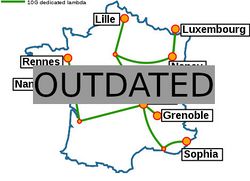Grid5000:Home: Difference between revisions
No edit summary |
No edit summary |
||
| Line 29: | Line 29: | ||
<br> | <br> | ||
== Random pick of publications == | |||
{{#publications:}} | {{#publications:}} | ||
Revision as of 12:49, 23 March 2018
|
Grid'5000 is a large-scale and versatile testbed for experiment-driven research in all areas of computer science, with a focus on parallel and distributed computing including Cloud, HPC and Big Data. Key features:
|
Random pick of publications
Five random publications that benefited from Grid'5000 (at least 2928 overall):
- Houssem Ouertatani. Efficient Deep Neural Architecture Search via Bayesian Optimization : An application to Computer Vision. Computer Vision and Pattern Recognition cs.CV. Université de Lille, 2024. English. NNT : 2024ULILB044. tel-05014154 view on HAL pdf
- Youenn Merel Jourdan, Mathieu Acher, Camille Maumet. In the Search for Truth: Navigating Variability in Neuroimaging Software Pipelines. SPLC 2025 - 29th ACM International Systems and Software Product Line Conference, Association for Computing Machinery (ACM), Sep 2025, Coruna, Spain, Spain. pp.129-135, 10.1145/3744915.3748470. hal-05158426 view on HAL pdf
- Pierre-François Gimenez, Jérôme Mengin. Learning Conditional Preference Networks: an Approach Based on the Minimum Description Length Principle. IJCAI 2024 - 33rd International Joint Conference on Artificial Intelligence, Aug 2024, Jeju, South Korea. pp.3395-3403, 10.24963/ijcai.2024/376. hal-04572196 view on HAL pdf
- Dorian Goepp, Samuel Brun, Quentin Guilloteau, Olivier Richard. Un prototype de cache de métadonnées pour le passage à l'échelle de NixOS-Compose. COMPAS 2024 - Conférence francophone d'informatique en Parallélisme, Architecture et Système, Jul 2024, Nantes, France. pp.1-8. hal-04632952 view on HAL pdf
- Jan Aalmoes. Intelligence artificielle pour des services moraux : Concilier équité et confidentialité. Intelligence artificielle cs.AI. INSA de Lyon, 2024. Français. NNT : 2024ISAL0126. tel-05014177 view on HAL pdf
Latest news
Failed to load RSS feed from https://www.grid5000.fr/mediawiki/index.php?title=News&action=feed&feed=atom: Error parsing XML for RSS
Grid'5000 sites
Current funding
As from June 2008, Inria is the main contributor to Grid'5000 funding.
INRIA |
CNRS |
UniversitiesUniversité Grenoble Alpes, Grenoble INP |
Regional councilsAquitaine |


